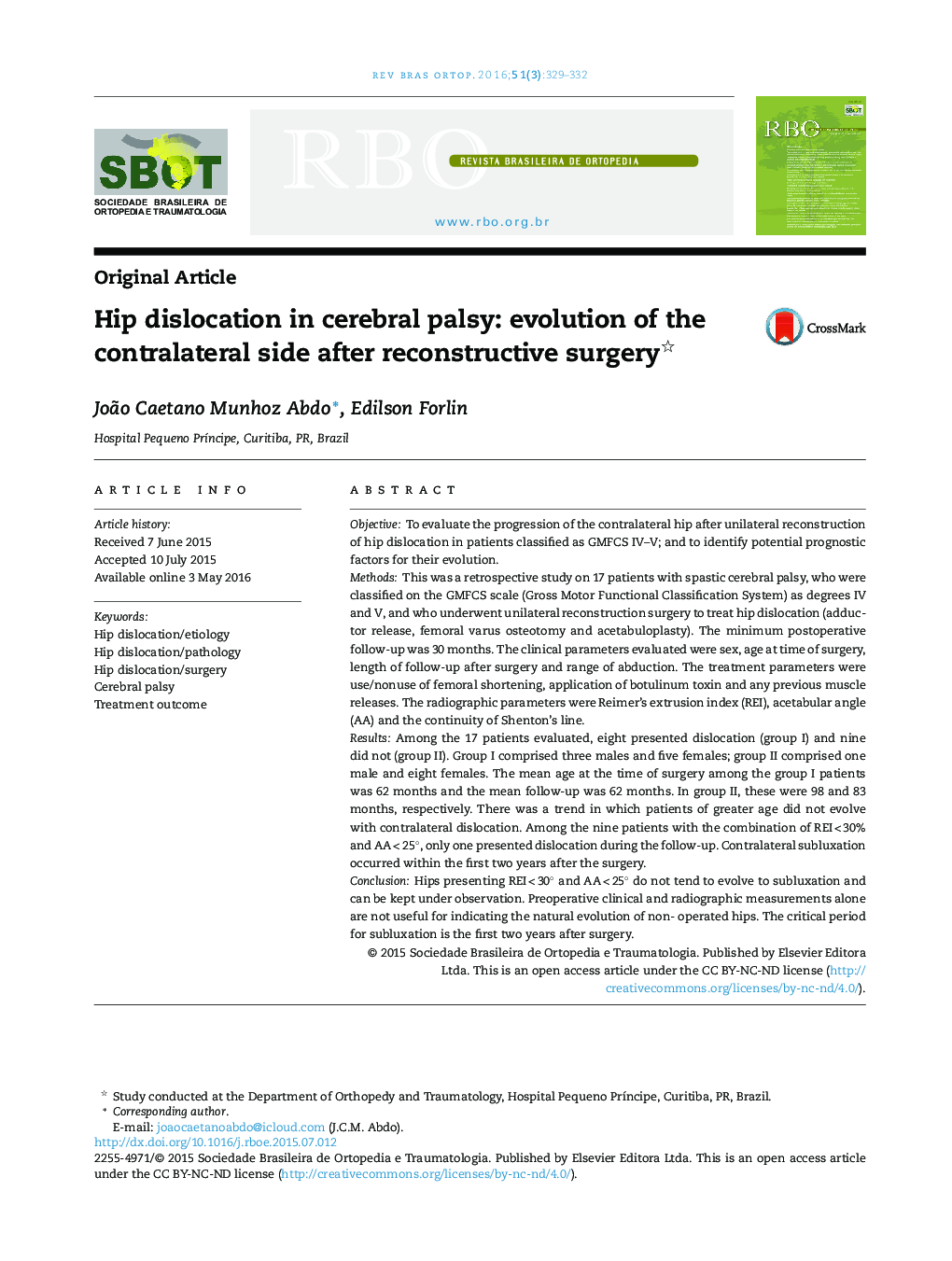| کد مقاله | کد نشریه | سال انتشار | مقاله انگلیسی | نسخه تمام متن |
|---|---|---|---|---|
| 2708279 | 1144896 | 2016 | 4 صفحه PDF | دانلود رایگان |
ObjectiveTo evaluate the progression of the contralateral hip after unilateral reconstruction of hip dislocation in patients classified as GMFCS IV–V; and to identify potential prognostic factors for their evolution.MethodsThis was a retrospective study on 17 patients with spastic cerebral palsy, who were classified on the GMFCS scale (Gross Motor Functional Classification System) as degrees IV and V, and who underwent unilateral reconstruction surgery to treat hip dislocation (adductor release, femoral varus osteotomy and acetabuloplasty). The minimum postoperative follow-up was 30 months. The clinical parameters evaluated were sex, age at time of surgery, length of follow-up after surgery and range of abduction. The treatment parameters were use/nonuse of femoral shortening, application of botulinum toxin and any previous muscle releases. The radiographic parameters were Reimer's extrusion index (REI), acetabular angle (AA) and the continuity of Shenton's line.ResultsAmong the 17 patients evaluated, eight presented dislocation (group I) and nine did not (group II). Group I comprised three males and five females; group II comprised one male and eight females. The mean age at the time of surgery among the group I patients was 62 months and the mean follow-up was 62 months. In group II, these were 98 and 83 months, respectively. There was a trend in which patients of greater age did not evolve with contralateral dislocation. Among the nine patients with the combination of REI < 30% and AA < 25°, only one presented dislocation during the follow-up. Contralateral subluxation occurred within the first two years after the surgery.ConclusionHips presenting REI < 30° and AA < 25° do not tend to evolve to subluxation and can be kept under observation. Preoperative clinical and radiographic measurements alone are not useful for indicating the natural evolution of non- operated hips. The critical period for subluxation is the first two years after surgery.
ResumoObjetivoAvaliar a evolução do quadril contralateral após a reconstrução unilateral de luxação de quadril em pacientes classificados como GMFCS IV-V e identificar possíveis fatores prognósticos da evolução.MétodosEstudo retrospectivo de 17 pacientes portadores de paralisia cerebral espástica, classificados pela escala GMFCS (Gross Motor Functional Classification System) em graus IV e V, submetidos a cirurgia de reconstrução unilateral de luxação de quadril (liberação de adutores, osteotomia varizante femoral e acetabuloplastia). O seguimento pós-operatório mínimo foi de 30 meses. Foram avaliados parâmetros clínicos (sexo, idade na ocasião do procedimento cirúrgico, tempo de seguimento após a cirurgia e amplitude de abdução), de tratamento (a feitura ou não de encurtamento femoral, aplicação de toxina botulínica e se houve procedimentos musculares prévios) e radiográficos (índice de extrusão de Reimers [IR], ângulo acetabular [AC] e continuidade do arco de Shenton [AS]).ResultadosDos 17 pacientes avaliados, oito deslocaram (grupo I) e nove não (grupo II). O grupo I contava com três pacientes do sexo masculino e cinco do feminino; grupo II apresentou um paciente do sexo masculino e oito do feminino. A média de idade no momento da cirurgia dos pacientes do grupo I foi de 62 meses e o tempo de seguimento médio foi de 62 meses. No grupo II foram de 98 e 83 meses, respectivamente. Houve tendência dos pacientes operados com maior idade não evoluírem com luxação contralateral. Dos nove pacientes que apresentavam a combinação de IR < 30% e AC < 25°, apenas um apresentou luxação no seguimento. A subluxação contralateral ocorre nos dois primeiros anos de pós-operatório.ConclusãoQuadris que apresentam um IR < 30° e AC < 25° não tendem a evoluir para subluxação e podem ser mantidos em observação. Medidas clínicas e radiográficas isoladas no pré-operatório não foram úteis para indicar a evolução natural do quadril não operado. O período crítico para subluxação são os dois primeiros anos do pós-operatório.
Journal: Revista Brasileira de Ortopedia (English Edition) - Volume 51, Issue 3, May–June 2016, Pages 329–332
